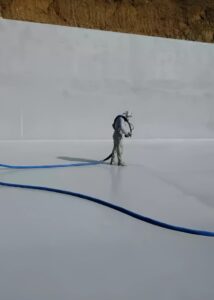Waterproofing Methods and Techniques: A Comprehensive Guide
Waterproofing is an essential aspect of construction and home maintenance that protects your property from water damage. Whether you’re dealing with a Roof leakage, a damp basement, or a wet bathroom, effective waterproofing can save you from costly repairs and potential health risks. In this blog post, we’ll explore various waterproofing methods and techniques that can help keep your property waterproof and secure.
Waterproofing involves creating a barrier that prevents water from entering or damaging a building structure or Homes or other structures. Water can cause significant damage to buildings, leading to issues like mold growth, structural weakening. By properly waterproofing your property, you protect it from these potential problems, extend its lifespan, and maintain its value.
Common Areas That Need Waterproofing:
Before diving into the methods and techniques, it’s important to know where waterproofing is most important. Common areas include:
- Roofs: To prevent leaks and damage from rainwater.
- Balconies and Terraces: To avoid water accumulation and seepage.
- Bathrooms: To prevent water leakage from showers, tubs, and sinks.
- Basements: To stop groundwater from seeping in and causing dampness or flooding.
- Foundations: To protect against groundwater and soil moisture.
Popular Waterproofing Methods:
- Cementitious Waterproofing: Cementitious waterproofing is one of the simplest and most commonly used methods. It involves applying a cement-based coating to surfaces like concrete or masonry to create a waterproof barrier. This method is widely used in bathrooms, basements, water tanks, and sewage treatment plants.
- Advantages:
- Easy to apply.
- Cost-effective.
- Provides a durable and seamless finish.
- Disadvantages:
- Limited flexibility.
- Can develop cracks over time due to structural movement.
2. Bituminous Coating: Bituminous coating, also known as asphalt coating, is another common waterproofing method. It involves applying a thick, sticky substance made from bitumen (a form of petroleum) to create a waterproof barrier.
- Advantages:
- Highly effective in preventing water penetration.
- Suitable for both above and below-ground applications.
- Durable and long-lasting.
- Disadvantages:
- Can be affected by sunlight exposure (unless modified with other materials).
- May require protective layers to enhance durability.
3. Liquid Waterproofing Membrane: Liquid waterproofing membrane involves applying a liquid coating, which hardens to form a rubber-like waterproof layer. This method is flexible, making it suitable for surfaces that may experience movement or expansion.
- Advantages:
- Highly flexible.
- Suitable for various surfaces, including roofs, balconies, and terraces.
- Provides seamless coverage.
- Disadvantages:
- Requires skilled application.
- More expensive than cementitious waterproofing.
4. Polyurethane Waterproofing: Polyurethane waterproofing involves applying a liquid coating made of polyurethane, which cures to form a seamless, waterproof layer. This method is highly effective for areas exposed to extreme weather conditions.
- Advantages:
- Excellent flexibility and elasticity.
- Suitable for various surfaces, including roofs, terraces, and balconies.
- Resistant to UV rays, chemicals, and abrasion.
- Disadvantages:
- Requires proper surface preparation.
- Can be more costly than other methods.
5. Bituminous Membrane: Bituminous membrane waterproofing is commonly used for low-sloped roofs. It involves laying down a membrane made of bitumen reinforced with materials like polyester or fiberglass.
- Advantages:
- Excellent water resistance.
- Suitable for large surface areas.
- Provides a thick, durable layer.
- Disadvantages:
- Requires skilled installation.
- Can be more expensive due to material costs.

Advanced Waterproofing Techniques:
In addition to the traditional methods, there are advanced waterproofing techniques that offer enhanced protection.
- Crystalline Waterproofing: Crystalline waterproofing involves applying a crystalline compound to concrete surfaces. This compound reacts with water to form crystals that fill and block the pores and capillaries in the concrete, making it waterproof.
- Advantages:
- Permanent and self-healing.
- Suitable for both positive and negative side waterproofing.
- Ideal for below-ground structures.
- Disadvantages:
- Requires specific conditions for application.
- More expensive than traditional methods.
2. Injection Grouting: Injection grouting is used to fill cracks, voids, and joints in concrete structures. A specialized grout material is injected into the cracks, which expands and hardens to block water penetration.
- Advantages:
- Effective for repairing and waterproofing existing structures.
- Can be used in areas with limited access.
- Provides long-lasting protection.
- Disadvantages:
- Requires professional expertise.
- Can be more costly due to specialized materials and equipment.
Tips for Successful Waterproofing
To ensure the success of your waterproofing project, consider the following tips:
- Choose the Right Method: Select the waterproofing method that best suits your specific needs and the area you’re working on.
- Prepare the Surface: Proper surface preparation is crucial for the effectiveness of waterproofing. Clean and repair any cracks or damage before applying the waterproofing material.
- Hire a Professional: While some waterproofing methods can be done as a DIY project, hiring a professional ensures quality work and long-lasting results.
- Regular Maintenance: Even after waterproofing, regular maintenance is essential to check for any signs of wear or damage and to address them promptly.




